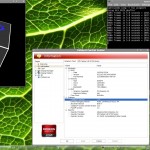AMD/ATI Catalyst fglrx & fglrx legacy news
Explanations of Hell
During June, with the version 12.6 (8.980) AMD decide to drop support for legacy radeon chipset from its main fglrx package and drop the time based release cycle.
So now if you are the owner of radeon hd2xxx to hd4xxx chipset family you will have to use the -legacy- version of fglrx, and
consequently if you have a radeon hd5xxx or above, you have to use the standard fglrx driver.
Then start the hell. After getting the new developed script from Sebastian Siebert, I will be able to offer the two versions. Unfortunately the two drivers can’t coexist in the same repository, the legacy drivers wants to install in place of normal one. This imply another limitation, you can’t have two graphics cards with differents generation at the same time.
So I decide to clarify (is that possible? :-)) the mess, and split the drivers in two distinct repositories. I use that excuse to also change the ati (deprecated brand name) and use new names: amd-fglx and amd-fglrx-legacy.
Don’t worry about your exiting installation, I will provide a symlink during the next 6 months at least for the old repositories. But read carefully the rest of the story, and apply any changes needed to your installation to be sure to continue to safely use the right driver.
I also decided to remove any version below 12.4 (8.961) in all repositories, except for openSUSE 11.2.
I need your help to spread those informations around the internet, and be sure that every user that need this driver know where and how to use it right. Tweet FbLike G+ forums, mailing list, private blogs Go now!
Release note about 12.6 and legacy 8.97.100
Both version can handle kernel 3.4 and 3.5
Sebastian Siebert warn us about the state of legacy

AMD catalyst control center and fgl_glxgears
These cards with the unofficial support of openSUSE 12.2 can run in the ideal case, just under 2 more years. However, one must keep in mind that the legacy driver is looked after, while AMD continues and eliminates errors found, but will not add new features. This can mean, among other things, that the next version of GNOME or KDE will not run with its 3D effects, especially when used with a desktop or Tumbleweed extra repository.
Sebastian’s post
If you have any comments, be do on his blog. Don’t be shy, you can leave there the result of test in english too 😀
or ask in forums, irc and ping freespacer.
See below what to do in case of troubles.
12.2 Factory rpms are presently available, use at your own risk, and report bugs in forums and Sebastian blogs.
Anyways, factory and 12.2 should keep their effort on debuging and testing widely the free radeon driver.
(more…)

